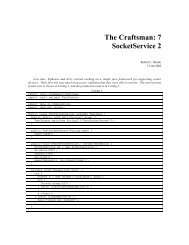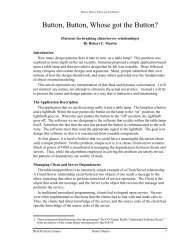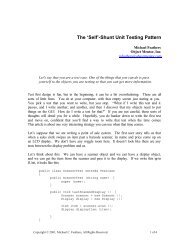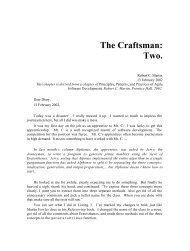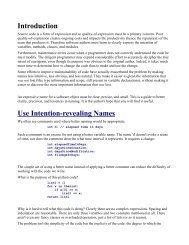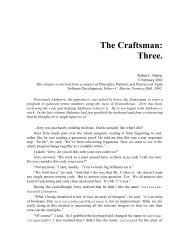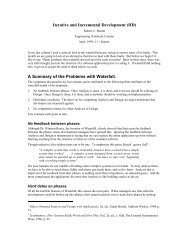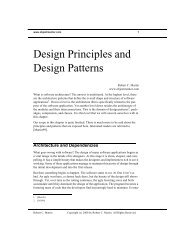Iterative and Incremental Development (IID) Faking it. - Object Mentor
Iterative and Incremental Development (IID) Faking it. - Object Mentor
Iterative and Incremental Development (IID) Faking it. - Object Mentor
Create successful ePaper yourself
Turn your PDF publications into a flip-book with our unique Google optimized e-Paper software.
<strong>Iterative</strong> <strong>and</strong> <strong>Incremental</strong> <strong>Development</strong> (<strong>IID</strong>)<br />
Robert C. Martin<br />
Engineering Notebook Column<br />
June 1999, C++ Report.<br />
In my last column, we looked at the fundamentals of an <strong>it</strong>erative <strong>and</strong> incremental process. We discussed<br />
how to divide a software project up into vertical slices <strong>and</strong> to analyze, design, <strong>and</strong> implement each in turn.<br />
We showed how to estimate project completion by extending the slice completion time by the number of<br />
slices. We discussed how the analysis <strong>and</strong> design documents become more complete as each slice is<br />
completed. We discussed how to use the feedback generated by the process to manage the scope, schedule,<br />
<strong>and</strong> staffing of the project.<br />
This month we are going to continue this exploration into <strong>IID</strong> by looking at how to deal w<strong>it</strong>h a corporate<br />
process that is entrenched in Waterfall. We’ll also discuss how to manage the project w<strong>it</strong>h milestones, how<br />
to get customers involved early, what happens if early slices are very wrong, <strong>and</strong> how to manage the<br />
creation of reusable frameworks.<br />
<strong>Faking</strong> <strong>it</strong>.<br />
Parnas 1 told us that we can never have a completely rational development process because:<br />
• A System’s users typically do not know exactly what they want <strong>and</strong> are unable to articulate all that<br />
they do know.<br />
• Even if we could state all of a system’s requirements, there are many details about a system that we<br />
can only discover once we are well into <strong>it</strong>s implementation.<br />
• Even if we knew all of these details, there are fundamental lim<strong>it</strong>s to the amount of complex<strong>it</strong>y that<br />
humans can master.<br />
• Even if we could master all this complex<strong>it</strong>y, there are external forces, far beyond a project’s control,<br />
that lead to changes in requirements, some of which may invalidate earlier decisions.<br />
• Systems built by humans are always subject to human error.<br />
• As we embark on each new project, we bring w<strong>it</strong>h us the intellectual baggage of ideas from earlier<br />
designs as well as the economic baggage of existing software, both of which shape our decisions<br />
independent of a system’s real requirements.<br />
Parnas goes on to observe that “For all of these reasons, the picture of the software designer deriving his<br />
design in a rational, error-free way from a statement of requirements is qu<strong>it</strong>e unrealistic.” But Parnas goes<br />
on to say that <strong>it</strong> is both possible <strong>and</strong> desirable to fake <strong>it</strong>.<br />
Suppose you have a corporate process that is so entrenched in waterfall that there is no short term<br />
possibil<strong>it</strong>y of changing <strong>it</strong>. Are you forced into ab<strong>and</strong>oning <strong>IID</strong> Not at all! Indeed, <strong>IID</strong> can be used as an<br />
<strong>it</strong>erative mechanism beneath waterfall.<br />
Design <strong>and</strong> Code as Analysis Tools.<br />
Consider Figure 1, which shows a project being divided up into <strong>it</strong>erative slices. During the first several<br />
slices, we are primarily exploring the problem domain. Though we are producing code, that code is<br />
incidental to the knowledge we are gaining. That knowledge has to do w<strong>it</strong>h the problem. Users, looking at<br />
1 Parnas, D. <strong>and</strong> Clements, P. 1986. A Rational Design Process: How <strong>and</strong> why to Fake It. IEEE<br />
Transactions on Software Engineering vol. SE-12(2) p251 as quoted by Booch in <strong>Object</strong> Solutions,<br />
Addison Wesley, 1996, p 9.
the behavior of those first few slices are adding new requirements <strong>and</strong> changing old requirements as they<br />
refine their own view of the problem. In short, this is analysis.<br />
Analysis Design Implementation<br />
High Level Analysis<br />
Slice<br />
Slice<br />
Slice<br />
Slice<br />
Slice<br />
Slice<br />
Slice<br />
Slice<br />
Slice<br />
Slice<br />
Slice<br />
Slice<br />
Slice<br />
Slice<br />
Slice<br />
Slice<br />
Known<br />
Start Date<br />
Figure 1. <strong>Faking</strong> a Waterfall w<strong>it</strong>h Increments.<br />
Known<br />
End Date<br />
One way to perform analysis is to build models of the problem domain <strong>and</strong> test those models against users’<br />
expectations. But another, very valid way to do analysis, is to build working increments of the project <strong>and</strong><br />
have the users examine those slices. E<strong>it</strong>her way, we are exploring the problem domain <strong>and</strong> underst<strong>and</strong>ing<br />
the problem to be solved.<br />
Code is a perfectly valid analysis tool. It can be used as an extremely accurate instrument to divine the<br />
requirements <strong>and</strong> test them against users’ expectations. So, at some point in the su<strong>it</strong>e of slices, we can<br />
declare analysis to be complete… Actually, analysis is never absolutely complete, rather after sufficient<br />
time we can say that <strong>it</strong> is complete enough for purposes of the waterfall.<br />
The same technique can be used for design. Once we are well into the creation of slices, the focus of the<br />
development shifts away from the problem <strong>and</strong> more towards the solution. During this phase we are<br />
hunting for the appropriate system arch<strong>it</strong>ecture. Slices are focussed upon finding the best way to solve the<br />
issues of the problem domain. Thus, code is being used as a design tool. Slice after slice adds knowledge<br />
to the structure <strong>and</strong> arch<strong>it</strong>ecture of the software.<br />
Remember, as each slice proceeds, we discover things about the previous slices that we don’t like. We<br />
immediately refactor those previous slices as part of the current slice. Thus, the design becomes ever more<br />
refined as the <strong>it</strong>erative process continues.<br />
Eventually, the arch<strong>it</strong>ecture of the system settles down, <strong>and</strong> we can declare design to be complete. From<br />
this point on the slices start cranking out w<strong>it</strong>h l<strong>it</strong>tle or no affect on previous slices. The problem has been<br />
determined, the arch<strong>it</strong>ecture is stable, <strong>and</strong> we are just implementing. Thus, the implementation phase has<br />
begun.<br />
It should be noted that there is no difference in activ<strong>it</strong>y at any point along this process. Each slice is<br />
developed according to <strong>it</strong>s own requirements. From slice to slice there is no difference in the process. Yet,<br />
as the slices pile up, the engineer’s knowledge of the project changes exactly as anticipated by waterfall.<br />
The first questions to be resolved are those about the problem domain. Later the solution domain becomes<br />
ever more clear. Finally, the implementation just starts to crank.<br />
So, if you have a corporate environment that is entrenched in waterfall, you can still use <strong>IID</strong> to fake a<br />
waterfall. Indeed, you can even produce all the necessary work products. For example, at the end of<br />
analysis, you can produce a problem domain model. Having done the slices that explore the problem
domain, you will be in a very good pos<strong>it</strong>ion to create that model. There will be very l<strong>it</strong>tle guesswork<br />
involved. The model will simply be a restatement of what the slices have taught you.<br />
Similarly, at the end of design, you can produce a design document that shows the design of the project.<br />
This document will be very accurate <strong>and</strong> will simply be a translation of the design that evolved while<br />
building the slices.<br />
From the top, this process can look exactly like a waterfall model. The only difference is that you are using<br />
code as a tool to explore the problem <strong>and</strong> solution domains. You are using the slices as a means to gather<br />
the problem domain <strong>and</strong> solution domain knowledge needed for the waterfall phases.<br />
Setting Milestones<br />
Of course, one of the major attractions of waterfall is the abil<strong>it</strong>y for managers to set milestone dates. This<br />
can still be done, even using an <strong>IID</strong>. However, milestones have a very different flavor in <strong>IID</strong> than in<br />
waterfall. In <strong>IID</strong>, a milestone is not a comm<strong>it</strong>ment. Rather <strong>it</strong> is a decision point.<br />
In <strong>IID</strong> we use the process to produce the data that tells us how we are doing against the schedule. We do<br />
not comm<strong>it</strong> to finishing certain slices at certain times. Rather we use the time that <strong>it</strong> takes to produce a<br />
slice as input to calculate when all the slices will be done. This gives us a way to measure the progress of<br />
the projects <strong>and</strong> to predict the completion date.<br />
However, <strong>it</strong> is unrealistic to suppose that a project should not have milestones. Indeed, <strong>it</strong> should! Those<br />
milestones might have comforting names like “Analysis Complete”, or “Design Complete”; so that from<br />
the top <strong>it</strong> looks like we are doing waterfall. Those milestones might be the completion of a certain work<br />
product, or they might be a date. Whatever the milestone is, <strong>it</strong> is some kind of event.<br />
The difference in <strong>IID</strong> is the way we treat that event. We do not treat <strong>it</strong> as a comm<strong>it</strong>ment. The project team<br />
does not promise to make all <strong>it</strong>s milestones. The project manager promises to manage the project through<br />
the milestones to obtain an acceptable end result. The project manager uses the milestones as events that<br />
trigger decisions.<br />
And those decisions should be wr<strong>it</strong>ten down ahead of time, <strong>and</strong> reviewed frequently. No one on the project<br />
should be surprised at what happens when a milestone is passed; <strong>it</strong> should all have been wr<strong>it</strong>ten down<br />
ahead of time.<br />
For example, lets say that we have a project w<strong>it</strong>h a milestone at the September 1 st , 2000. This milestone<br />
does not have a completion cr<strong>it</strong>erion. Rather <strong>it</strong> is simply a date at which a decision will be made. That<br />
decision might look like this:<br />
• If slice 7 is complete, continue according to plan.<br />
• If slice 6 is complete, then eliminate slice 12 from the plan.<br />
• If slice 5 is complete, then eliminate slices 12 <strong>and</strong> 15 from the plan.<br />
• If Slice 4 is complete, then eliminate slices 12 <strong>and</strong> 15 from the plan <strong>and</strong> add another engineer<br />
by Oct 1 st .<br />
• If slice 4 is not complete, then cancel the project.<br />
Getting Customers Involved Early.<br />
During the analysis “phase” of <strong>IID</strong>, <strong>it</strong> is cr<strong>it</strong>ical to involve customers, or their representatives in the<br />
evaluation of the evolving project. When the customers are actually able to touch <strong>and</strong> feel the project, they<br />
will invariably decide that what they are seeing is not what they really wanted. They will subm<strong>it</strong> changes.<br />
This is a good thing! We want the changes early. We want the customer to be confident that we are<br />
building the right things. So the project plan will thrash a b<strong>it</strong> during this in<strong>it</strong>ial phase. There are likely to<br />
be slices added, other slices removed, <strong>and</strong> many slices significantly altered.
As time progresses, <strong>and</strong> the analysis “phase” draws to a close, the users will gradually reduce the number<br />
of changes they want made. It is unlikely, however, that they will every completely stop. Indeed, as the<br />
users’ environment <strong>and</strong> business problems change, they are likely to come increase the number of change<br />
requests.<br />
Every such change affects the array of slices in the project. It will affect some that have been completed,<br />
<strong>and</strong> some that are yet to be completed. It may add or remove slices too. But since we have been measuring<br />
our “speed” in terms of slice completions, we will be able to estimate the schedule effect of each change.<br />
Users, when confronted w<strong>it</strong>h the schedule ramifications, can be given the option of accepting the change to<br />
the schedule, or postponing the change.<br />
All of this has the effect of putting the users in control. The users never view the project as a black p<strong>it</strong> of<br />
manpower from which nothing but arcane documents emerge. Rather the users actively participate in the<br />
development <strong>and</strong> evolution of the project.<br />
When Slices go Wrong.<br />
Of course getting the users involved in this way means that there will be some substantial amounts of<br />
rework as those users make changes. Indeed, there will also be rework as the problem domain <strong>and</strong> solution<br />
domains settle down. Sometimes the rework can be so significant that the team decides to reimplement<br />
whole slices. So long as this is infrequent, this is not a bad thing.<br />
Once <strong>it</strong> is determined that a slice is just plain wrong, <strong>it</strong> should be discarded <strong>and</strong> reimplemented. This is<br />
especially true if the slice is early in the project <strong>and</strong> is defining cr<strong>it</strong>ical arch<strong>it</strong>ectural elements. We don’t<br />
want that incorrect arch<strong>it</strong>ecture poisoning the rest of the project. Indeed, <strong>it</strong> is much more likely that the<br />
project milestones will have good outcomes if such errant slices are discarded, than if they are kept.<br />
Keeping them will force everyone to have to work around the problems <strong>and</strong> slow the whole project down.<br />
Refactoring <strong>and</strong> repairing them eliminates the roadblocks.<br />
One could argue that an approach that focussed more on up front analysis <strong>and</strong> design would eliminate or<br />
m<strong>it</strong>igate this kind of rework. This is doubtful. When a slice goes wrong, there is no doubt that <strong>it</strong> has gone<br />
wrong. But when an analysis model or design model goes wrong, we often don’t find out about <strong>it</strong> until we<br />
are implementing <strong>it</strong>. Thus, while errors in slices are discovered early <strong>and</strong> repaired before they can do much<br />
harm; errors in analysis <strong>and</strong> design models aren’t discovered until late after many other models <strong>and</strong><br />
decisions have been predicated upon them.<br />
Managing Reusable Frameworks.<br />
This leads us to the topic of reusable frameworks. Such a framework should never be a slice, or a su<strong>it</strong>e of<br />
slices. A reusable framework that is developed by <strong>it</strong>self will probably not be very reusable. Rather a<br />
reusable framework needs to be built in the context of application slices. And more than one if possible.<br />
If you need to build a reusable framework, then take care choosing your slices. As always, make sure that<br />
they are slices that are rich in user features, <strong>and</strong> that cut across the whole system as opposed to<br />
implementing subsystems. Have the slice developers collaborate on creating the reusable framework by<br />
insisting that nothing be put into the framework unless <strong>it</strong> is reused by more than one slice. Never put<br />
anything into the framework because <strong>it</strong> “seems like a good idea”. Rather, insist that the only things that go<br />
into the framework are things that would otherwise need to be repeated in two or more slices.<br />
The engineers can negotiate on the correct abstractions that allow the reusable elements to be correctly<br />
accessed from each of their slices. This ensures that the abstractions in the framework are su<strong>it</strong>able for reuse<br />
by at least two slices. And where two are able to reuse <strong>it</strong>, more are likely to follow.<br />
Conclusion<br />
This brings to a close our discussion of <strong>it</strong>erative <strong>and</strong> incremental development. In this series of articles we<br />
have explored the failures <strong>and</strong> fallacies of the waterfall model, have shown how to divide a project up into
increments that are binary deliverables. We have shown how to estimate project completion <strong>and</strong> how to<br />
manage the project to have a good outcome.<br />
The recommendations <strong>and</strong> techniques that have appeared in this series of articles have worked for me, <strong>and</strong><br />
for others. But they are not perfect. They will not solve all software development problems. Software will<br />
still be late, still be intractably complex, still be perniciously difficult to develop. Software is, after all,<br />
Software. However, the process we have outlined does have the benef<strong>it</strong> that <strong>it</strong> produces data. And a<br />
process that produces data can be managed. A process that does not produce data, cannot be managed.



